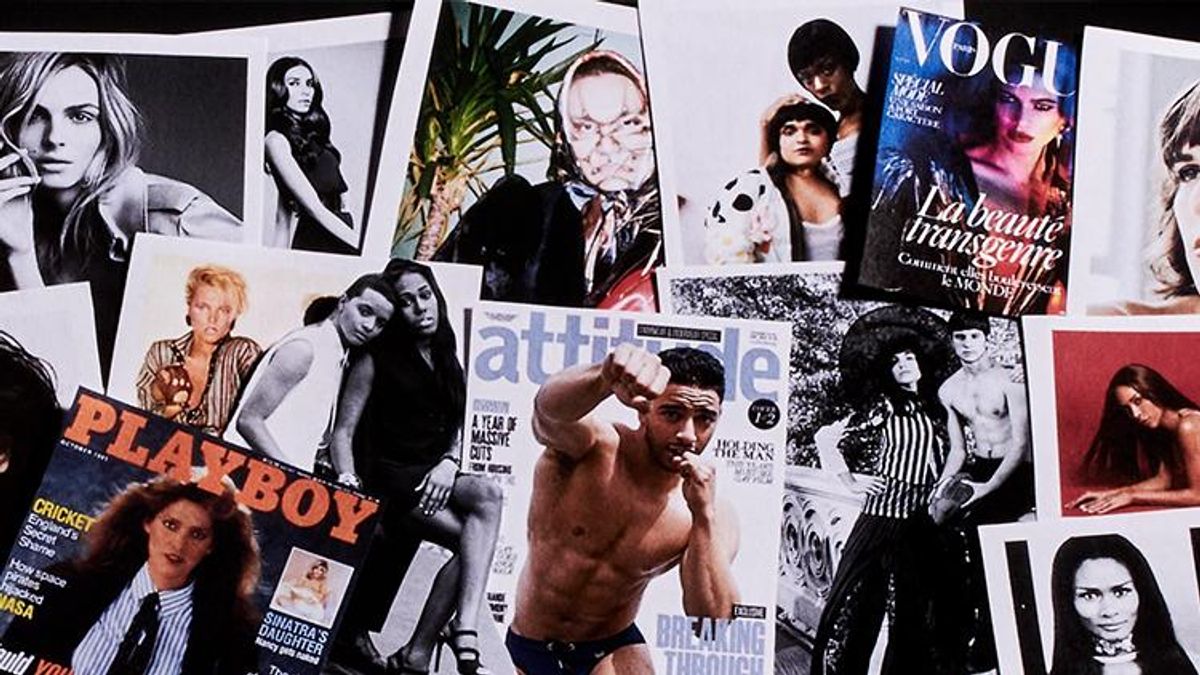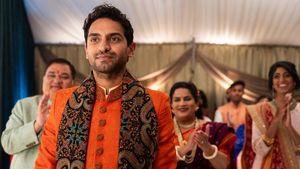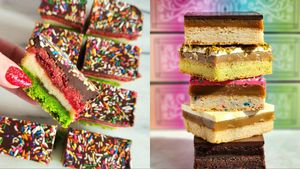In early September, headlines boasted that Marco Marco underwear's latest fashion show at New York Fashion Week was "groundbreaking." Featuring the likes of Dominique Jackson, Trace Lysette, Laith Ashley, and Aydian Dowling, the much-publicized event was said to be the first in NYFW history to boast a runway that exclusively featured transgender models. But in the days following, many of those stories had to be edited, and their proclamations dialed back, as social media began to point out that while Marco Marco probably now holds the record for the most trans male models in a runway show, the label's presentation was not the first of its kind. Another brand, created by a trans woman of color, had beat it out for an "all trans" runway three years prior.
In 2015, Gogo Graham put on her first NYFW show, displaying her fifth collection of one-of-a-kind pieces for trans femmes. The event, held in the lobby of the Ace Hotel, was a love letter to trans femmes and their journey, and was the first in a string of shows that centered on their narratives and experiences. (The second runway collection, presented for Fall 2016, focused on the violence inflicted on them.) Both shows also highlighted the talents of trans femmes, as Graham has worked with this community to produce the presentations, create soundtracks, design sets, and shoot imagery. She then cast community members as models and design collaborators. According to Graham, the brand's impetus, in its most recent iteration, is "to create work opportunities for trans women of color, because redistribution of financial capital is the most effective way to empower people within the capitalist economic structure in which we survive." The designer calls out a very different prerogative than that of Marco Marco, whose inclusion arguably starts and stops with a blockbuster fashion show.
This past September boasted the most trans representation ever during fashion month, which encapsulates the series of fall runway shows held in New York, Milan, London, and Paris. The Fashion Spot, which keeps track of diversity each runway season and publishes its findings, reported that 83 openly trans women were being cast for 52 shows across the four weeks. (These numbers did not count the trans men at Marco Marco; but they do include the 15 women.) Model Hunter Schafer led the pack with 17 shows (hitting all four cities), and Teddy Quinlivan walked in 11, both contributing to a history-making month.
"Changes are happening," says Cecilio Asuncion, founder of Slay Model Management, the first trans modeling agency in Los Angeles. "We can only strive for more so that it becomes the status quo."
But as trans models begin to find increased representation in the industry, they face a new set of challenges -- like historical erasure -- as brands attempt to tokenize them, and use them as pawns in a culture where identity politics are at the forefront. Confronting those challenges with the access and platform they do have is an opportunity afforded to them not only through society's changing attitudes, but through inroads made by their predecessors, who are part of a collective, 60-plus-year history that, to many, is unknown.
***

April Ashley
It was a pair of friends, actresses Sarah Churchill and Julia Lockwood, who got April Ashley to move back to London after she underwent gender confirmation surgery in Casablanca. It was 1960, and she was 25 at the time, making her one of the first Britons to have the procedure. When Ashley followed Churchill and Lockwood's advice, and returned to her home country later that year, the duo introduced her to the city as a model. The introductions worked swiftly, and Ashley signed with an agent named Signon, who began booking her out six months in advance for projects with photographers like Brian Duffey, Richard Dormer, and Terence Donovan -- some of the top names in their field.
"They all knew about my operation -- they all knew who I was," Ashley told interviewers for an as-yet-untitled documentary about her life, now in development. "None of the photographers gave a damn about my past. They wanted me in their portfolio." But she also began to get runway and editorial work. Her high point was appearing in British Vogue, shot by photographer David Bailey. "To come from the backstreets of Liverpool, and here you are in the most glamorous situations...it was a dream come true," she said.
But that dream came to an abrupt end in 1961 when tabloids outed her, causing all brands to stop working with her. And though she tried to restart her career (she signed with an agency in Spain), jobs were canceled once her identity was unveiled.
Ashley has since been honored with an exhibition at the Museum of Liverpool, April Ashley: Portrait of a Lady, which attracted a reported 1 million visitors. She was one of the first on a timeline of trans models that stretches through to today. On that timeline, for the first half-century, trans models worked with varying success, typically without discussing their gender in an effort to book jobs. Thus, most made it into the historical record only if they were outed.
After Ashley came Tracey Norman, known to some as Tracey Africa, who hit the height of her career early, appearing as the face of a new hair dye in Clairol's line in 1975. The company made a hue based on the color of Norman's hair (Born Beautiful, No. 512), and because of its status as one of the brand's best-selling boxes, they extended her first contract by four years, marketing the product for a total of six.
But that wasn't Norman's only success: She got her break shooting for Vogue Italia with Irving Penn, at a rate of $1,500 a day, alongside models like Peggy Dillard. She'd go on to shoot for Ultra Sheen, Avon, and Essence before being outed among fashion insiders around 1981. A relocation to Paris briefly revived her career, working with Balenciaga, but after moving back to the United States, her career ended when word of her gender spread again. (Elsewhere, South African-born Lauren Foster's career also ended shortly after a 1980 spread in Vogue Mexico.)
The story of Caroline Cossey, also known as Tula, is more complex. After working with Australian Vogue, Harper's Bazaar, and a string of small brands throughout the 1970s (she appeared topless in a series of denim ads, among others), Cossey was slotted for a job that has become a high point of her legacy: a cover spread for a 1981 issue of Playboy. The gig came as a lead-up to the release of the James Bond movie For Your Eyes Only, in which Cossey appeared as an extra. And though she was outed in 1982 by a British tabloid, she made a comeback in 1991, shot by Playboy for a solo spread that described her as a "beautiful woman who was born a boy." The accomplishment added her name to a short list of out trans models who have posed for the magazine, though all the others modeled for international editions.
Thierry Mugler routinely cast trans models to walk in his runway shows. Teri Toye opened the Steven Sprouse show in 1984. (She served as its muse.) She then walked as an out trans model for Mugler, Chanel, and Jean Paul Gaultier in her three-year career, in addition to shooting for German Vogue. Many point to her as the first out trans model.
Connie Fleming, known as "Connie Girl," also walked for Mugler (one of her runway appearances inspired Aquaria's denim look on season 10 of RuPaul's Drag Race), as did Roberta Close, who appeared on the cover of Brazilian Playboy in 1984 and 1989. Close joined supermodels Naomi Campbell and Linda Evangelista (as well as actor Tracee Ellis Ross) on the runway in 1991. Fleming also walked for Vivienne Westwood and was shot by Steven Meisel.
In 2003, Barbara Diop, a Senegalese model, made international headlines. After working in Milan, walking runways, and even making an appearance in Vogue Italia, she moved to Cape Town to continue her career. In 2003, when she led Team Zimbabwe as part of the Cricket World Cup, she was outed in the local press, and though she initially denied being trans, she eventually admitted it as the story became international news.
"I've always said that the person that walks through the door first leaves the door cracked," Norman told New York Magazine of her own legacy in 2015. "There was a perception that a transgender woman couldn't be passable and work in fashion magazines and land contracts. I proved that wrong. I left the door cracked for other [transgender people] to walk through." And while Norman--as well as Ashley, Cossey, Diop, Foster, Fleming, and Close--inched that door open as a passable model who didn't discuss her gender, in 2009 it got a shove when Isis King appeared on America's Next Top Model as the first openly trans model of the franchise. She lasted only five episodes, but in doing so, she brought the conversation to the surface of public consciousness. King helped widen the gap enough for a new generation of trans models to walk through the door and be publicly out and successful in the industry.
***

Leyna Bloom by Anastasia Garcia for Chromat.
In 2008, when Leyna Bloom moved to New York at 17, she didn't see much existing visibility for trans models in fashion. King's appearance would come a year later on Top Model (a show on which Bloom herself once considered competing), and Lea T would make her debut in 2010 as a face of Givenchy. (It was stipulated in contracts that then creative director Riccardo Tisci disclose her gender in all interviews.) But before any of that, Bloom had already found a group of women to look up to.
"It was the ballroom queens that walk face," Bloom says. "They walk the category I walk. I saw Tanay Pendavis and Onjenae Milan walking down this runway, and it was like they were walking down a runway in Paris. I saw Tracey Africa. I saw these women that embodied this femininity that I possessed." And so, in forming her own style from a combination of these women (as well as Beverly Johnson and Cindy Crawford), Bloom began to find her way in fashion.
An early shoot with Antoine Verglas -- a photographer who has shot supermodels like Claudia Schiffer and Stephanie Seymour for Elle, Vogue, and Victoria's Secret--went viral. It stemmed from a recommendation by Verglas's wife, who ran into Bloom in a furniture store. From there, Candy, a magazine founded in 2009 dedicated to celebrating trans people, got in touch with Bloom. She made her appearance in a Candy cover story for the magazine's fifth-anniversary "transversal" issue, released in December 2014. She was shot alongside King as well as other trans women like Janet Mock, Yasmine Petty, and Geena Rocero (who had come out in a TED Talk earlier that year).
"It was all of these amazing, dynamic women," Bloom says. "I kept asking, Why me?" The Candy spread served as Bloom's coming-out and set her on a path that would see her work with brands like Chromat, LaQuan Smith, and the Blonds; become the first trans woman shot for Vogue India, in 2017; and, most recently, appear in Jeremy Scott's Moschino for H&M ad campaign.

Candy Magazine's 5th Anniversary Issue Featuring Janet Mock, Laverne Cox and Geena Rocero on the cover.
Bloom's success came in a flood of firsts for out trans models in fashion. Carol Marra became the first trans woman to walk Brazil's Fashion Rio in 2010. And though Lea T and King got early starts--the former covered Elle Brazil and LOVE in 2011, while the latter was a face of American Apparel in 2012--the winds seemed to change in 2014, following an ad campaign for Barney's that was shot by Bruce Weber and featured 17 trans models. That same year, Ines Rau was photographed for a special issue of Playboy and Lea T booked a Redken hair campaign -- the first major beauty campaign for an out trans model. The following year, the first three all-trans agencies opened in the U.S.: Slay in Los Angeles; Transcendence Icon in Boise, Idaho; and Trans Models in New York (started by Peche Di, a trans woman who appeared in Weber's ad). Elsewhere in the world, there was the launching of Bold in India, while Apple Models in Thailand had already opened the first trans division of an existing agency in 2014.
Since then, trans women have inked deals with cosmetics brands (Andreja Pejic was first with Makeup for Ever in 2015) as well as other beauty brands (Valentina Sampaio with L'Oreal in 2016, for example), been signed to IMG Worldwide (Hari Nef in 2015), appeared in lingerie campaigns (Aurel Haize Odogbo in 2016), and walked in fashion week shows all over the world, including India, where Anjali Lama appeared in Lakme Fashion Week in 2017. They've graced the covers of Elle UK (Nef in 2016), Harper's Bazaar India (Rocero and Norman in 2016), and Vogue Paris (Sampaio in 2017). Trans men are also forging paths: Laith Ashley appeared in the Barney's ad and has also done work for H&M, Diesel, Gypsy Sport, and Rounderbum. Casil McArthur has walked for Coach and Marc Jacobs, and done ads for Kenneth Cole. But representation brings new challenges.
"I think of myself as just a model who happens to be trans, that's it," says Torraine Futurum, who has worked with Proenza Schouler, Shiseido, Urban Outfitters, and others. "When they call someone a trans model, it sort of sends the message that people should only reach out to that model when they specifically want a trans person, which is limiting." And that tokenizing can be evidenced in a variety of ways. Case in point: When Bloom appeared in Vogue India (which went on to do a full-length profile of Lama in October), she was misidentified as Rocero. Additionally, models have to fight notions of a "trans look" or aesthetic.
"Casting directors often have a preconceived notion of what a trans person looks like," Asuncion says. "What they don't understand is that there is not one look. A challenge we often have is [our models] don't fit this mold or image that casting directors have in their head."
As Bloom points out, these challenges are layered over the roadblocks any other minority model might face. Trans bodies that are older, disabled, non-white, or fall outside the industry's "straight size" definitions find themselves at odds with the establishment's gatekeepers. That said, there have been some recent landmarks for intersectional models. In September, Aaron Philip, a black, trans, disabled teen signed to Elite Models, and Chella Man, a deaf, Jewish-Asian, genderqueer model signed to IMG. Whether this is a trend or a sustained change in the industry will only be told over time, but as with Ashley, Norman, and Toye, it's a series of firsts that could give birth to a legacy of their own.
Related: 18 PORTRAITS OF TRANS MODELS THAT REPRESENT STRENGTH AND CONFIDENCE




























































































